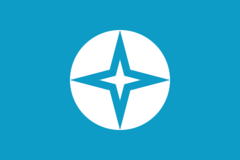Renaissance Party: Difference between revisions
m (→Legacy) |
m (Text replacement - "Shaftonist-Republican Alliance" to "Federalist Republican Alliance") |
||
| Line 35: | Line 35: | ||
|predecessor = | |predecessor = | ||
|merged = | |merged = | ||
|successor = [[ | |successor = [[Federalist Republican Alliance]]<br>[[Coscivian National Congress]] | ||
|headquarters = Tandhurin Island, [[Valēka]]<br>[[Kartika]]<br>[[Cities of Kiravia#Vaśyansar|Vaśyansar]] | |headquarters = Tandhurin Island, [[Valēka]]<br>[[Kartika]]<br>[[Cities of Kiravia#Vaśyansar|Vaśyansar]] | ||
|newspaper = Herald of Rebirth | |newspaper = Herald of Rebirth | ||
| Line 94: | Line 94: | ||
===Legacy=== | ===Legacy=== | ||
''See also: [[Federalist Lodges]]'' | ''See also: [[Federalist Lodges]]'' | ||
The political legacy of the Renaissance Party was carried on by the [[Shaftonist Republican Alliance]] and [[Coscivian National Congress]] caucuses. The SRA inherited the more politically and economically liberal elements of the Renaissance Party, while the CNC inherited its more statist and nationalist elements. Many provincial affiliates of the [[ | The political legacy of the Renaissance Party was carried on by the [[Shaftonist Republican Alliance]] and [[Coscivian National Congress]] caucuses. The SRA inherited the more politically and economically liberal elements of the Renaissance Party, while the CNC inherited its more statist and nationalist elements. Many provincial affiliates of the [[Federalist Republican Alliance]], especially in [[Æonara]] and the [[Overseas Regions]], continue to use the Renaissance Party name and embrace other aspects of its platform and identity. | ||
Contemporary provincial parties that have retained the Renaissance Party name and traditions include: | Contemporary provincial parties that have retained the Renaissance Party name and traditions include: | ||
Revision as of 00:38, 22 January 2024
Renaissance Party Plaiduv Inoguamsk | |
|---|---|
 | |
| Secretary-General | Dáud Múamat Koreıśin (last) |
| Eternal President | V.R. Sarosten |
| Eternal Chairman | Séan Kæśek |
| Founder | V.R. Sarosten |
| Founded | 211XX |
| Dissolved | 211YY |
| Succeeded by | Federalist Republican Alliance Coscivian National Congress |
| Headquarters | Tandhurin Island, Valēka Kartika Vaśyansar |
| Newspaper | Herald of Rebirth |
| Student wing | Insane Gangsta Disciples |
| Rural wing | Freesoil Councils |
| Ideology | Rennovationism Shaftonist republicanism Anti-communism Geoconservatism Conservative liberalism National liberalism Principlism factions: Restarkism (from 211XY) Shafto-socialism (until 211XZ) |
| National affiliation | National Reunification Front (1939-1985) National Renewal Movement (1985-199X) |
| Colors | Teal |
| Rump Stanora (211XQ) | 200 / 225
|
The Renaissance Party was a major political party during the later years of the Federal Period of Kiravian history and subsequently the dominant party of the Kiravian Remnant following the Kirosocialist takeover of Great Kirav.
Platform:
1. No anime
2. Stay based, my friends
4. Legalize drunk driving
History
Origins
Antebellum Federacy
Civil War
Kiravian Remnant
Reunification
Legacy
See also: Federalist Lodges The political legacy of the Renaissance Party was carried on by the Shaftonist Republican Alliance and Coscivian National Congress caucuses. The SRA inherited the more politically and economically liberal elements of the Renaissance Party, while the CNC inherited its more statist and nationalist elements. Many provincial affiliates of the Federalist Republican Alliance, especially in Æonara and the Overseas Regions, continue to use the Renaissance Party name and embrace other aspects of its platform and identity.
Contemporary provincial parties that have retained the Renaissance Party name and traditions include:
|
|
|
|
Platform
Occidental scholars generally describe the antebellum Renaissance Party as a progressive-conservative party supportive of established value systems but opposed to the institutional status quo, marketing itself as a movement to realise existing civic ideals where those in power had failed to. Common threads that would remain part of the Party's ideological mantle throughout its history include: